|
作者:Frank Cifaldi LucasArt今年退出舞台着实是电子游戏行业一大不幸损失,但对我们许多人而言,其意义不仅局限于此。 相较于该公司被取消的项目,传说中被裁员150人,或者像迪士尼这种多样化或国际化的大公司居然如此轻视游戏开发的消息,LucastArt的退场损失更为严重。 对我们来说,LucasArts之死无异于梦想之死。这个梦也许是因怀旧而美丽,但终究还只是个梦罢了。也许在能够于主流游戏开发史中催生出最具创新性工作室的独特环境成形时, 这个梦就会卷土重来。 这是一个遥不可及的梦,但只要LucasArt的名字犹存,我们当中的一小部分人就不会放弃这个梦想。 该工作室推出了许多创新,但不可否认的是,该公司的最强大遗产是80至90年代的图像冒险游戏。例如《Grim Fandango》、《猴岛的秘密》、《Zak McKracken》以及《the Alien Mindbenders》等独特、故事性以及通俗易上手的冒险游戏。 如今算起来,距离最后一款出色的LucasArts游戏问世已有15年了,但行业中许多人仍然将这些游戏奉为游戏喜剧写作,以及故事驱动型游戏的标准。 但为什么会这样呢?为什么我们仍然将这些游戏奉为行业的顶点?为什么开发者在讨论自己的游戏故事时还要频频提及《猴岛》?为什么我们仍然在心中将“LucasArts”一词与图 像冒险游戏开始前的启动画面联系起来,尽管该公司在过去10年中并未发布一款游戏? 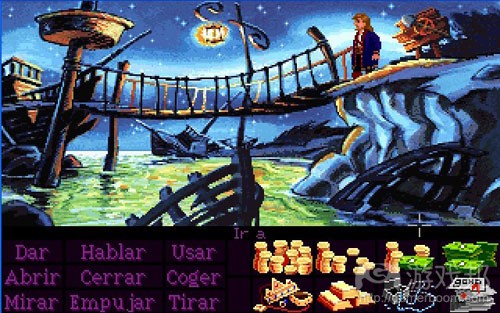 Monkey-Island(from le-serpent-retrogamer)
为此,我们通过Facebook和Twitter采访了游戏开发社区的相关成员,提出了以下问题: 让LucasArts经典冒险游戏经久不衰的要素是什么呢?为什么我们今天仍在讨论这些游戏? 我们收到了如下大量回复。 在这些回复中,Lucasfilm Games元老David Fox以内部人的身份发表了独到的见解(见本文第2部分)。 它们经常会打破第四堵墙(游戏邦注:属于戏剧术语,指一面在传统三壁镜框式舞台中虚构的“墙”。它可以让观众看见戏剧中的观众。从另一个层面讲,观众在电影、电视节目 中出现,可以被看做是“打破第四面墙”)并让你觉得自己也置身于笑话中。 它令人愉快而鼓舞人心。即使是在今天,我对游戏开发天堂的想象仍然像是起源于自己玩这些游戏时候的体验,以及它们是在世界上最自由和创意的环境中创造出来的暗示。 ——Mike Mika(Other Ocean Interactive开发总监) 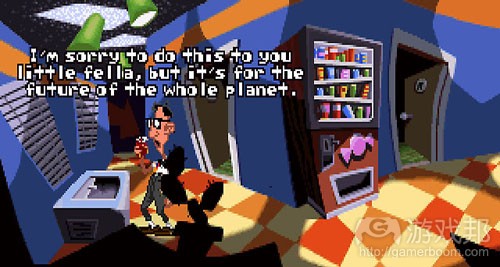 day of the tentacle(from gamasutra)
人们一直在讨论制作喜剧游戏的难度,这也许是真的,但LucasArts却让这个过程看起来很轻松。我每两年都会和妻子一起重温《Day of the Tentacle》,这款游戏确实堪称完美 。 我从这款游戏中学到如何成为有趣的人,尽管该游戏要求玩家控制场景的时间,也学到了如果要真正悟出一个笑话你该在何时松手。 ——Adam Rippon(Muteki Corporation公司的《Dragon Fantasy》开发者) 它们是将原创主题、有趣的故事与通俗易用的玩法融合在一起的罕见典型。在某些方面,它们实际上难以在许多现代工作室中获得批准,因为创造大预算项目的新IP极具风险。 它们仍然非常重要,因为当今的许多可行创意就是起源于那个黄金时代,前辈们的开拓引导了我们的创新,其怀旧感仍然极具启发意义。 ——游戏设计师Tyler Sigman(代表作包括《HOARD》、《Sonic Rivals》)  the dig(from gamasutra)
作为游戏行业人士,我喜欢LucasArts经典冒险游戏的原因在于,游戏行业中的每个人似乎都玩过这些游戏。所以你可以用这些游戏作为大家的讨论话题(例如,“我们需要一个为 似Manny的角色”),更重要的是你可以从某人最喜欢的LucasArts冒险游戏中了解对方的喜好和个性。 例如,“你是《猴岛》粉丝?那我懂了。还是关心《Maniac Mansion》中将仓鼠放进微波炉的事情?不错,你喜欢《The Dig》?!好极了,我也是……” 因为人人都玩过这些游戏,它们实际上成了游戏行业人士的性格测试。 ——Chris Charla(微软工作室) 对于每位成长为愤世嫉俗的青少年或20岁左右青年的人来说,这些游戏是出自我们同龄人之手的作品。它们对我们过去的生活极富意义,它们是由跟我们走过同一条路的人制作的 。 这些游戏经得起时间考验,因为其故事很犀利,并且很尊重观众的智商,极具幽默感,到今天我们仍可见“Lucasfilm”或“LucasArts”的身影,当我们需要一次伟大的冒险以 及同好友分享时,它就会将我们带回孩时的记忆。 ——Paul Marzagalli(NAVGTR董事顾问)  maniac mansion(from gamasutra)
《Maniac Mansion》是我第一次玩过的冒险游戏之一,当时我并不是骨灰级玩家……但我还是觉得自己的掌握能力与许多更资深的同龄人一样。 它们是大师级的故事家,其中有许多可爱而令人难忘的角色喷出聪明的对话。在每一次小小的胜利时,我都觉得自己真的成了一名游戏玩家,并且更加清楚地认识到为何如此多精 明而有才华人会专注于这项爱好。 ——电子游戏PR专员Elizabeth Olson(她在担任《Game Informer》杂志创刊编辑时学到了许多冒险游戏知识) 像Ron Gilbert和Tim Schafer等LucasArts编剧、设计师创造了十分出彩的角色和对话,我认为人们至今仍在讨论这些早期作品的一大原因就是我们仍记得自己最喜爱的游戏场景。 它们还实现了一种不造作的杰出感,不会太把自己当回事。《猴岛2》玩法的结尾是一个奉劝玩家去做除了玩游戏之外的其他任务清单。今天还有谁敢这么做呢? ——游戏作曲人Peter McConnell(曾为LucasArts冒险游戏作曲,其中包括《猴岛2》、《Indiana Jones and the Fate of Atlantis》、《Sam & Max Hit the Road》、《Day of the Tentacle》以及《Grim Fandango》 《猴岛2》对我来说是一个启示!它让我知道自己可以进步!我可能搞砸一切,再次尝试,最终通关!我一直都喜欢这种题材的游戏,但由于难度太大总是无法真正享受其中,最后 终于有人说,“嘿,我们只玩有趣的部分怎么样。”我的意思是,游戏中精美的画面、真正有趣的对话,这一切都很棒,但真正令我陷入其中的却是它容易上手的特点。 ——Ian Adams(Z2Live工作室游戏设计师) 它们是低压力的机制的胜利组合,并因真正优秀的故事而驱动。 其中许多角色都是有血有肉的形象,他们所处的幻想世界具有大量令人难忘的细节,在许多情况下不时闪现创造者的个性和其他特点。 每款90年代中期的LucasArts冒险游戏本身都是令人回味无穷的,它们一起代表了该工作室辉煌灿烂的黄金时代,其命运与亚特兰蒂斯大陆(游戏邦注:一片传说中有高度文明发展 的古老大陆,被称作大西洲)一样突然间在90年代晚期灾难性地陷落在深海之下。 ——Craig Adams 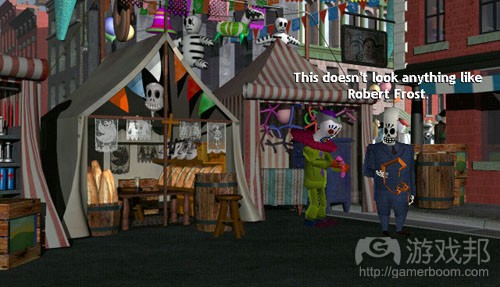 grim fandango(from gamasutra)
《猴岛的诅咒》仍然是我玩过的最有趣的游戏之一。之后是《Loom》这款具有独特用户界面,以非常方式运用音效的游戏。最让我难忘的是《Grim Fandango》这款从旧版SCUMM游 戏演变至3D的游戏——它很古怪、好玩、神秘,当然还有独特。 游戏中的技术一直在进步,但游戏设计如果无懈可击,就会久经时间考验。 ——游戏设计咨询师和作家Rusel DeMaria 它的游戏世界至今让人觉得具有原创性和新鲜感,其写作也充满智慧和令人难忘,每个角色都是如此特立独行和非凡。 即使是在那个时期,它们也成功地跨越了文化边界。许多跟我同一辈的西班牙人(我的出生地)都还深深记得《猴岛》中人物拿剑决斗赌咒要赢的那些誓言。许多来自欧洲的冒险 游戏也将在多方面受到LucastArts游戏的影响,例如直接引用其中的谜题。它们真正令北美地区之外的玩家产生了共鸣。 ——研究人员兼学者Chara Fernandez Vara 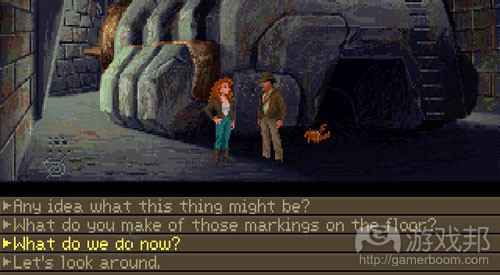 fate of atlantis(from gamasutra)
坦白地说,我都不知道该如何说起,他们有如此多出众的游戏。他们的冒险游戏,例如《Maniac Mansion》、《Day of the Tentacle》、《Escape from Monkey Island》、 《Full Throttle》、《Grim Fandango》几乎定义了一个时代。 《Indiana Jones and the Fate of Atlantis》可能是我最喜欢的冒险游戏之一。将 Indiana Jones 与冒险游戏题材结合起来效果真的很棒。对我来说Fate of Atlantis不但是我 最喜欢的冒险故事,而且也是史上最佳的 Indiana Jones故事之一。 ——Infinity Ward执行制作人Mark Rubin 《疯狂大楼》具有无缝的完美。基于同样的方式,《马里奥》游戏也延续了一代又一代,让无数青少年沉浸于可怕的房子中拯救自己的好友。 我喜欢故事,清楚且吸引人的画面,这么多年以来我仍然能够感受到Michael主题的乐趣! ——Lateef Martin(Miscellaneum Studios) LucasArts的冒险游戏之所以是永恒的是因为它们将整整一代人带到了游戏的真正潜能中!我清楚地记得自己每次获得来自LucasArts的全新冒险游戏时的激动感。我甚至会在回家 的路上开始阅读游戏指南。我知道不管我购买的是哪款游戏,我将按压按键打开计算机,然后被要求到一些疯狂的地方。 也许你会发现一个需要帮助的新孩子?你可以给某些人一瓶沙士,阅读《National Inquisitor》或加足马力开着你的摩托车。你可以问绿色和紫色触手的区别,并为9号选择一个 标签。你必须打开并使用自己的大脑,但是真正鼓舞人心且富有想象力的方式则是年复一年地投入时间。 ——Chris Campbell(Big Fish Games工作室首席制作人) 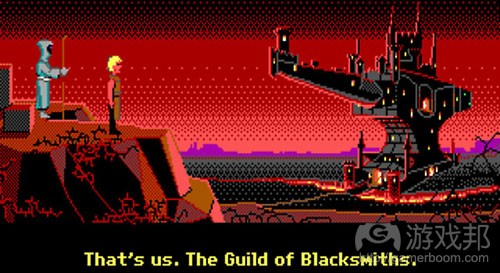 Bobbin Threadbare(from gamasutra)
我们很容易对冒险游戏吹毛求疵。一般说来那些来自LucasArts的游戏都未存在什么可挑剔的毛病。它们是充满热情的游戏创造者的产物。除了出色的执行,游戏中自由的冒险更是 玩家与角色共同享受的乐趣。不是通过代理,而是通过他们精心塑造的世界而传达直接体验。 我认为它们在我们心中的地位与作为强大的第一代玩家和游戏开发者的地位相当。LucasArts的冒险游戏是伴随着我们的形成性格时期发展起来,似乎从那时起就与我们相伴相随了 。 ——Gareth Jenkins(独立开发商36peas) 它们不是游戏,它们是任何玩家之前经历的不一样的故事和体验。开发者有自己需要创造的故事和体验,他们也拥有机会去做这些。 ——Seth Sivak(独立开发商Proletariat) 我认为所有游戏开发者都欣赏机智的游戏,你可以于他们谈论他们在《触手也疯狂》中最喜欢的谜题。 LucasArts的冒险游戏是让你每隔几年便回到其中的游戏稀有品种,虽然不记得所有谜题,但却仍然再次去解决它们,并享受着傻傻的角色及其对话。 ——grand Davies(Endgame Studios) 在冒险游戏中,动词是机制,文字是游戏玩法。它们可以和谐共存。LucasArts便在这方面做得很好—-即转变恐怖感,乐趣与奇怪的病态,我始终对此心存感谢。 ——Ubisoft Montreal的编剧C.J.Kershner 甚至在今天看来游戏中的对话也还是很有趣。虽然游戏机制过时了,谜题很困难,有时候还很让人费解,但是今天我还会为了大段的对话去玩这些游戏。不管是基于同一个对象尝 试每种行动,还是耗尽对话树从游戏中编写每一滴幽默。这绝对是经得起时间考验的文字作品。 ——Andrew Goulding(墨尔本工作室Brawsome) LucasArts的游戏在我心中具有一个特殊地位,不管是《Loom》,《Koronis Rift》,《Ballblazer》还是《猴子岛》系列。不只是因为它们是当时最具开创性的游戏,同时它们还 具有一些特别的元素能够激发我的想象力,让我有“假使……会怎么样?”以及“如果我这么做是否会比较好”等想法,并通过整合一些玩家想要探索并创造自己的故事的机制到 游戏中而增添了游戏乐趣。 这一基本理念是我仍会于Bioware的员工分享的内容。如果你能够创造一个足以调动玩家的想象力并机器他们的热情的世界,他们便会将其带到一个全新的高度。 ——Alistair McNally(BioWare) 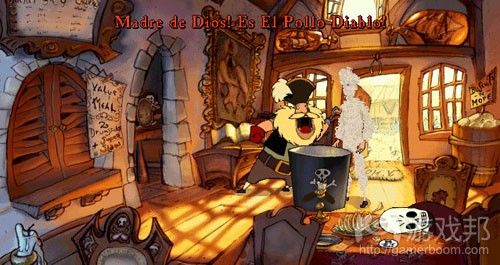 The Curse of Monkey Island(from gamasutra)
经典的LucasArts冒险游戏之所以是用户的是因为它们的影响力是永恒的。 我喜欢《Full Throttle》的黑色电影元素,这是在我知道什么是黑色电影元素之前就喜欢着的。我喜欢《触手也疯狂》的Bernard,Hoagie以及Laverne原型,这也是在我看过青少 年电影素材之前的事。 但是撇开特定的参照与灵感,经典的LucasArts冒险游戏也是永恒的,因为其优秀,机智,认真,让人印象深刻且具有人道的文字内容就是永恒的,这是所有的这些游戏所创造起来 的基础。 ——Steve Gaynor(The Fullbright Company) 角色就让我无法离开游戏了,捕捉游戏间的玩笑和小品让我觉得自己也是游戏中的一部分,因为这也是我所开的玩笑。 游戏中也有一些严肃的时刻,但是幽默元素总是伴随着我。就像Monty Python的草图,这些时刻深深地留在了我的脑海中,伴随着愉快的欢笑,甚至在20年后也会出现在我的意识 中。 从根本上说,LucasArts的游戏深深打动了我。 ——Kyle Kulyk(Itzy Interactive) 对于我来说,这些游戏之所以是永恒的是因为结合了让人难忘的角色以及引人发笑的对话。人们会记得游戏中糟糕的文字内容——“你的所有基地都是属于我的”,也会记得出色 的文字内容——“这是我看过的第二大的猴子头”。许多游戏尝试着通过模仿其它成功的游戏而创造出优秀的文字内容,但最终却变得非常单调。 ——Jordi Fine(游戏设计师) 多亏了《Full Throttle》,我开始理解到优秀的故事对于一款游戏的强大作用。《The Dig》,《猴子岛》,《冥界狂想曲》等游戏世界都深深吸引了我。故事,世界以及角色的 每个细节都被具体化了,即超越了我之前看过的任何游戏中的内容。 ——Dan Silvers(Lantana Games) 为了让本文足够圆满,我们询问了LucasArts Games的元老级任务David Fox,听听他对于为何该工作室的图像冒险游戏仍备受尊重的看法。以下是他的回答。 当我于1982年开始在Lucasfilm工作以来,我们便承受了巨大的压力。我们一直思考着该如何创造出与电影《星球大战》那样引人注目的游戏,并且也不需要挖掘来自《星球大战》 宇宙的理念?尽管20时机80年代的其它游戏公司不得不依赖于游戏的收入而谋生,但是我们却能够奢侈地花大量时间去创造心目中的理想游戏,即花好几年时间进行实验,尝试各 种新内容,挑战极限,并且无需承受来自市场营销,焦点测试,甚至是George Lucas的压力。我们也有时间去创造公司文化,并从Lucasfilm文化中断的地方重新开始。 所以我们花了好几个月的时间在思考有关游戏的内容,与一些聪明的设计师进行头脑风暴,不断改善,修改,并删除那些无效的部分(或者整个理念),然后重新开始。我们曾经 的一大布告是“不能发行一些垃圾内容”,我们也希望确保永远都不会这么做。 也许在这样的创造性支持环境下,我们将能够跳出固有思维模式进行思考,并花时间去添加许多背景故事和细节,然后反复地调整再调整。直到我们觉得是时候发行了。 的确,我们在与一些非常出色且富有创造性的人合作。这并不是一种巧合。多年来,每当需要雇佣新的设计师时,他们都会受到严厉的批评,并接受全部设计师的面试。他们是否 能够适应?他们是否具有协作性?是否具有创造性?这就像是需要所有人做出投票才能迎来新人的俱乐部。我们不会改变文化或者质量标准,所以我们有责任重视这一过程。我们 的游戏便是最好的证明。 我们从未想过自己的游戏能够在货架上持续超过1年或2年。要知道硬件的更新速度非常快。我们也从未想过人们会为了在更加强大的平台上继续玩我们的游戏而创造模拟器和 SCUMMVM。我想知道,如果我们知道这点,我们对于自己的设计的自我意识是否会增强?  Zak McKracken and the Alien Mindbenders(from gamasutra)
我认为区别我们的图像冒险游戏于其它“竞争游戏”的主要元素在于,我们创造谜题的目标是让人们在解决谜题的时候能够愉快地笑出来。我们想要人们在想出答案时有“啊哈” 的时刻。我认为其它图像冒险游戏有时候太过小气了,即添加种种游戏障碍有时候正是导致其用户流失的关键。 我知道,当我们继续完善这些游戏的图像时,我们将能够学到更多,而上述的一些元素甚至是我们较早之前遇到的。我们想要与玩家一起游戏,并在他们创造性地想出解决方法的 时候给予奖励。 相关拓展阅读:篇目1,篇目2(本文由游戏邦编译,转载请注明来源,或咨询微信zhengjintiao) Why are We Still Talking about LucasArts’ Old Adventure Games? by Frank Cifaldi This story is being highlighted as one of Gamasutra’s best stories of 2013. The gutting of LucasArts earlier this week was a tragic loss for the video game industry, but for many of us, it was more than that. It was more severe of a loss than the cancelled projects, the rumored 150 job losses, or the between-the-lines message that even a company as diverse and global as Disney puts little value in game development. No, for us, the death of LucasArts was the death of a dream. A dream rose-tinted by nostalgia, perhaps, but a dream nevertheless. A dream that one day, the unique environment that birthed what may have been the most wildly creative studio in mainstream game development history would, somehow, come back. It was a far-fetched dream, but as long as the name LucasArts continued to exist, a small part of us held onto it. A lot of innovation came out of the studio, but without a doubt, the strongest legacy it left behind was its series of graphical adventure games from the ’80s and ’90s. Unique, story-driven, easily-accessible adventures with titles like Grim Fandango, The Secret of Monkey Island, and Zak McKracken and the Alien Mindbenders. By most accounts the last truly great LucasArts (or Lucasfilm Games, if you go back far enough) game was released almost 15 years ago, and yet, many in the industry still hold these titles as the benchmark not only for comedy writing in games, but for narrative-driven games of all kinds. But why is that? Why is it that we still consider these games among our pinnacle achievements as an industry? Why do developers still namedrop Monkey Island in pitch meetings when discussing their proposed game’s story? Why do we all continue to mentally associate the word “LucasArts” as the splash screen we see before a graphical adventure game, even though the company hadn’t released one inover a decade? We turned to our game development community to find out. Specifically, we asked via Twitter and Facebook: What is it about the classic LucasArts adventure games that makes them timeless? Why are we still talking about them today? We’ve collected a good majority of the answers below. Following these responses, as a special treat, Lucasfilm Games veteran David Fox attempts to answer that question with his own insider perspective. (Image credits: MobyGames, Lemon64, The Scumm Bar) Helping Green Tentacle get a recording contract was the least of your worries in Maniac Mansion. They often broke the fourth wall and made you feel like you were in on the joke. As if the joke was “Can you believe we get to make these things?” It was exhilarating and inspiring. Even today, my fantasy of what game development nirvana feels like stems from my experience playing those games, and the insinuation that they were created in the most liberating and creative environment on earth. - Mike Mika, development director at Other Ocean Interactive People always talk about how hard it is to make a comedy game, and maybe it’s true, but LucasArts made it look easy. I still go back and play Day of the Tentacle every couple years with my wife, and man, that game holds up thanks to its perfect delivery. From that one game I have learned a lot about how to be funny despite players having control over the timing of a scene, and I learned when you really just have to yank control away from them in order to drive a joke home. - Dragon Fantasy creator Adam Rippon, of Muteki Corporation They were that rare combination of original themes and interesting stories mixed with accessible gameplay. In some ways, they are exactly what is hard to greenlight in many modern studios because of the risk of creating new IP on big-budget projects. They are still relevant because many of today’s working creatives grew up in that golden age, so that trailblazing taught us how to be creative, and the nostalgia continues to inspire. - Game designer Tyler Sigman (HOARD, Sonic Rivals) What I love about the classic LucasArts adventures as a game industry person is that it seems like every single person in the game industry has played them. So a) you can use any of the games as shorthand when discussing something (“we need like a Manny character for this”) and more importantly b) you can instantly learn a lot about someone by what LucasArts adventures they like most. “Ok, you’re a Monkey Island guy? Got it. Still focused on putting the hamster in the microwave in Maniac Mansion? Cool. You like The Dig?! Right on…” Because everyone has played them, they’re basically a Rorschach test for people in the game industry at this point. - Chris Charla, Microsoft Studios Day of the Tentacle’s unique premise saw players finding creative ways to make objects travel through time. For every adolescent who turned into a snarky teenager or a sardonic twenty-something, here were games made by our peers. They were games that made sense for where we were in life, made by people who walked the same road as we did. The games endure because the stories are sharp and respect the audience’s intelligence, the humor is inclusive, and because still today when we see “Lucasfilm” or “LucasArts,” it brings us back to those childhood memories when all we wanted was a great adventure and friends to share it with. - Paul Marzagalli, board of advisors, NAVGTR. Maniac Mansion was one of the first adventure games I ever played, in the early days of Game Informer. It didn’t seem to matter that I wasn’t an expert gamer… I felt like I got as much out of it as my more veteran peers. They were expert storytellers, spinning engaging takes with endearing and memorable characters spouting clever dialog. And with each little victory I felt like I was really becoming a gamer and better understanding why so many smart and talented people were dedicated to the hobby. - Video game PR professional Elizabeth Olson, who cut her teeth on adventure games as the founding editor of Game Informer magazine. Indiana Jones and the Fate of Atlantis is regarded by fans as a worthy successor to the trilogy of feature films. LucasArts writers and designers like Ron Gilbert and Tim Schafer brought to the table a wonderful knack for character and dialog, and I think the reason people still talk about those early titles today is that we all have favorite scenes that we still remember. They also achieved a kind of unstudied greatness that comes from not taking yourself too seriously. Monkey Island II actually ended gameplay with a long list of things you could go out and do other than play video games. Who does that now? - Game composer Peter McConnell, who contributed music to LucasArts adventures including (but not limited to) Monkey Island II, Indiana Jones and the Fate of Atlantis, Sam & Max Hit the Road, Day of the Tentacle, and Grim Fandango Monkey Island II was a revelation for me. I could make progress! I could mess up, try again, and eventually get through things! Here was this genre of games that I’d always liked the idea of, but never been able to really enjoy due to difficulty, and someone had finally said, “Hey, how about we ONLY have the fun part.” I mean, the beautiful art, the genuinely funny dialog, all of that was wonderful, but the thing I really fell in love with was being able to actually get through the game. - Ian Adams, game designer at Seattle’s Z2Live They were built on a winning combination of low-stress mechanics and propelled by genuinely good writing. Many of the characters had heart and soul, the imagined worlds they inhabited were crafted with an impressive attention to detail, and in many cases the personalities and some aspect of the of the creators came through. Each of the mid-’90s LucasArts adventure videogames is memorable on its own, but taken together they represent a studio’s glorious golden age that, in a fate similar to Atlantis (sorry), seemed to suddenly and cataclysmically sink beneath the ocean waves in the late ’90s. - Craig “Superbrothers” Adams Full Throttle, probably the only game to ever start you off in a dumpster outside of a biker bar. The Curse of Monkey Island is still one of the funniest games I’ve ever played. Then there was Loom, a beautiful game with a completely unique user interface that used music in a way never used before or since, as far as I know. Finally on my truly memorable scale is Grim Fandango, a 3D evolution from the older SCUMM games — quirky, funny, mysterious and, once again, unique. Technology in games is ever improving, but game design, when it’s done impeccably, is timeless. - Game design consultant and author Rusel DeMaria Manny Calavera feels a little ripped off in 1998′s Grim Fandango. The worlds still feel original and fresh, and the writing was witty and memorable, where every character is distinct and remarkable. Even in their time, they managed to cross cultural boundaries. Many people in my generation in Spain, where I’m from, know by heart most of the insults to win at sword fighting in Monkey Island. Many adventure games coming from Europe will include nudges to LucasArts games, from direct quotes to similar puzzles (see Ben There, Dan That, or Ceville). They really struck a chord outside of North America. - Researcher and scholar Clara Fernandez Vara Honestly, I don’t even know where to begin; they had so many titles that stand out. Their adventures games basically defined an era, with Maniac Mansion, Day of the Tentacle, Escape from Monkey Island, Full Throttle, Grim Fandango. Indiana Jones and the Fate of Atlantis is probably one of my favorite adventure games of all time. Indiana Jones and the adventure game genre go together… well, like Fedoras and bull whips. And for me Fate of Atlantis delivered not only one my favorite adventure stories but also one of the best Indiana Jones stories ever. Certainly better that the Crystal Skull. Sorry George. - Infinity Ward executive producer Mark Rubin Maniac Mansion was crafted with seamless perfection. In the same way Mario is timeless and can be enjoyed by any generation, so can the point and click adventure of a group of teens infiltrating a creepy house to rescue their friend. I enjoyed the storytelling, the clean and appealing aesthetic and after all these years, I can still beatbox Michael’s theme! Lateef Martin, Miscellaneum StudiosLucasArts adventures are timeless because they introduced an entire generation to the real potential of what a game could do! I remember vividly the excitement anytime I would GET a new adventure game from LucasArts. I’d get so excited I’d READ the manual front-to-back before getting home. I always knew that regardless of the game I purchased, I could PUSH the button toTURN ON the computer where then I’d be invited to GO TO some crazy place. Perhaps you’d find a NEW KID that needed help? You could GIVE someone a bottle of root beer, READ the National Inquisitor, or PULL up on your motorcycle going full throttle. You could ask WHAT IS the difference between a green and purple tentacle and PICK UP a ticket for the Number Nine. Yes you had to OPEN your mind and USE your brain, but what a wonderfully inspiring and imaginative way to spend years and years and years. Chris Campbell, senior producer, studios at Big Fish Games It’s easy to pick holes in adventure games. Generally speaking, those that came out of LucasArts didn’t have any. They were clearly a product of passionate game makers. In addition to their brilliant execution though, their permissive adventures were something that the player could enjoy along with the characters. Not through agency, but through direct experience of their carefully crafted worlds. Ultimately though, I think their place in our hearts is as much to do with them being brought into our collective consciousness as the first sizeable generation of gamers and game developers were finding their feet. LucasArts adventure games played out alongside us during our formative years and have, as such, stuck with us since. Gareth Jenkins, of independent developer 36peas These were not games, they were stories and experiences that were unlike anything players had experienced before. The developers had stories and experiences that they need to create, and they were given a chance to do just that. Seth Sivak, of independent developer Proletariat I think all game developers appreciate clever games, and you can always talk to them about their favorite puzzle in Day of the Tentacle (putting the sweater in the dryer for 400 years to shrink it to hamster size for example). LucasArts adventure games are a rare breed of game you can return to every few years, not remember all the puzzles, and still have a blast trying to solve them again whilst enjoying the wonderfully goofy characters and their dialogue. Grand Davies, Endgame Studios In adventure games, verbs are mechanics and writing is gameplay. The two can live in harmony. LucasArts made some of the best — by turns thrilling, funny, strangely morbid — and I will always be grateful for that. C.J. Kershner, scriptwriter, Ubisoft Montreal The dialog is still funny, even today. The gameplay mechanics are dated, the puzzles are hard, and sometimes obscure, but I play them today mostly for the lines of dialog. From trying every action on an object, or every object with every other, to exhausting dialog trees to wring every last drop of humor from the game. It is definitely the writing that stands the test of time. Andrew Goulding, of Melbourne-based Brawsome LucasArts games have always had a special place in my heart; from Loom to Koronis Rift to Ballblazer and the Monkey Island series. Not (just) because they were ground breaking titles for their time but they had that extra special element which fired my own imagination and made me think “what if?” and “wouldn ’t it be great if I could do this,” elevating a fun game with great mechanics into a world which you wanted to explore and make up your own stories in. This basic idea is one that I still talk about to BioWare staff. If you can create a world which engages people’s imaginations and fuels and impassions them, they’ll take it to new heights. Alistair McNally, BioWare Classic LucasArts adventures are timeless because their influences are timeless. Frankenstein and film noir and buddy comedies and teen movies, classic pulpy sci-fi and swashbuckling movie serials crossed with irreverent, real, believable characters living in outrageous worlds. I loved Full Throttle’s neo-noir before I knew what film noir was. I loved Day of the Tentacle’s Bernard, Hoagie, and Laverne archetypes before I’d ever seen the teen movie source material. But regardless of the specific references and inspirations, classic LucasArts adventures are timeless because great, clever, earnest, memorable, human writing is timeless, and that is the foundation on which all those great games were built. Steve Gaynor, of The Fullbright Company The characters just stuck with me, and catching the in-jokes and cameos between games just made me feel like I was somehow connected, because they were in- jokes that I got. There were serious moments in the titles, but it’s the humor that will always be with me. Like Monty Python sketches, these moments have just wormed their way into my mind and stuck, curled up with an amused smirk, waiting to spring to the forefront of my consciousness even 20 years later. Basically, LucasArts titles infected my brain. Kyle Kulyk, Itzy Interactive What makes these games timeless for me is the combination of memorable characters and their hilariously witty dialogue. People remember bad writing in games – “All your base are belong to us” and they remember great writing – “That’s the second biggest monkey head I’ve ever seen!” Many games try to achieve great writing by imitating the successes of others, but end up falling flat somewhere in the middle. Game designer Jordi Fine It was thanks to Full Throttle that I began to understand the true power that a great story could have on a game. The Dig, Monkey Island, Grim Fandango… these worlds pulled me in and kept me there. Every detail of the story, worlds, and characters was fully fleshed out beyond anything else I had ever seen in games. Dan Silvers, Lantana Games To wrap this article up, we asked David Fox — a Lucasfilm Games alum who was there from the very beginning — to contribute his thoughts on why the studio’ s graphical adventures are still held in such high esteem. Here’s what he had to say. When I first started working at Lucasfilm in 1982, we had a heavy burden to bear. How could we create games that were as compelling as the Star Wars films but without mining ideas from the Star Wars universe? While other game companies of the 1980s had to rely on the income from their games to survive, we had the unheard-of luxury of taking our time to get our games right, with years to experiment, try new things, push the envelope, and with no pressure from marketing, focus testing, or even George Lucas. We also had time to develop our company culture, starting where the Lucasfilm culture left off. So we’d spend months thinking about our games… brainstorming with the other brilliant designers, refining, reworking, revamping, tossing out the parts that didn’t work (or the entire concept) and starting again. One of our edicts was “don’t ship shit” and we wanted to make sure we never did. Maybe working in a creatively supportive environment like that, one that wasn’t just focused on the bottom line, enabled us to think outside the box, take time to add tons of backstory and detail… tune, tune, and tune again. Until WE felt it was time to ship. Unheard of then and I’m sure even more unusual now (other than with indie games done by people in their spare time). And yes, we had wonderfully creative people to work with. And that wasn’t an accident. For years, whenever a new designer was about to be hired, they had to run the gauntlet… interviewing with all the other designers. Would they fit in? How collaborative were they? How creative? It was a club where all the members had to vote to let the next one in. We weren’t about to change our culture or quality level, so we all took this responsibly very seriously. And our games showed it. We never thought about our games lasting for more than a year or two on the shelves. Hardware was changing so fast then. We didn’t consider that people would build emulators and SCUMMVM so they could continue playing them on successively more powerful platforms. I wonder if we had known that if we wouldn’t have been much more self-conscious about our designs? I think one thing that differentiated our graphic adventure games from “the competition” was our goal of creating puzzles that made people laugh with joy when they solved them. We wanted people to have that a-ha! moment when they figured it all out. I think “the competition’s” graphic adventures were sometimes mean-spirited, adding barriers to play that sometimes seemed like they were messing with the player. I know that we learned a lot as we continued to refine the art of creating these games,
|